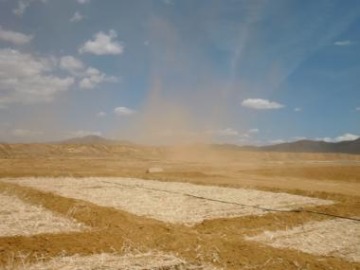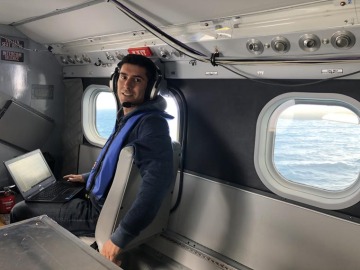Dust isn’t just dirt kicked up in the air. Airborne particulates include water, organic material and metals. Some of what’s found in them can pollute the environment and create health issues in people in and around mines.
Identifying what’s in dust emissions from mining operations is part of proposed research in an industry-academic cooperative by

A windy morning showing dust blowing from the tailings site at the Iron King Mine.
Photo courtesy of Raina Maier
the Center for Environmentally Sustainable Mining (CESM). The CESM collaborates with the University of Arizona’s Lowell Institute for Mineral Resources and Superfund Research Center.
By recruiting mining industry partners to work with UArizona researchers, the CESM facilitates work on relevant projects with real-world applications. It currently runs a cooperative funded by five industry partners to tackle revegetation and ecosystem regeneration. Research partnerships also originate from issues brought up by the center’s technical advisory committee, which includes representatives from mining companies and independent consultants.
“A number of times the CESM technical advisory committee has asked us to address dust,” says Dr. Julie Neilson, CESM director. “Dust emissions is a big issue in the Southwest and arid and semi-arid regions.” The motivation for the current work on dust emissions came from a graduate student’s work as an intern with a mining company. This level of study gives the mining industry an opportunity to tackle the difficult challenges in dust emissions. “Through CESM, we’re trying to build up more partnerships with companies who might be interested in the dust issue,” says Dr. Armin Sorooshian, UArizona professor of chemical and environmental engineering.
A new scope of work aims to characterize dust flux from mining operations by paying particular attention to their chemical makeup, which can include nitrates, sulfates, toxic metals and metalloids. The research will also develop models to identify how much of regional particulate concentrations come specifically from mining operations.
“A major issue is the emissions of particulates that can negatively impact air quality and public health,” says Sorooshian. “Tailings in particular present an area with arguably the highest potential for dust emissions of any land surface type that exists. There’s the added feature of some of the highest levels of contaminants in the form of metals and metalloids like arsenic, lead and cadmium.”
“We’re looking for the micro- and macro-perspective of dust emissions.”
Dr. Armin Sorooshian
Industry partners who join the consortium would provide some resources to conduct the study and access to sites on where particulate samples could be collected for analysis. In turn, they receive reports on the scientists’ findings.
There’s a lot to learn about mining dust emissions
Mining companies face regulatory fines if their operations have been found to have emitted large amounts of particulates. However, the effects of mining dust emissions still are poorly understood, according to Sorooshian. “There is more to be learned about factors controlling dust emissions, including wind, land surface type and human activity,” he says. “There are gaps in the characteristics of dust emissions, including their size distribution, composition and relative abundance to dust emissions that occur anyways … from other sources such as large cities and the natural desert.”

Armin Sorooshian as the flight scientist during a research flight on a Navy Twin Otter aircraft, flying close to the ocean surface to collect data about aerosol particles and meteorological parameters
Sorooshian’s research focuses on the effects of aerosol particles in the atmosphere, from how they interact with clouds and impact climate change to what they do to the environment and human health. Using samples from mines in Iran and Arizona, he has examined the chemical composition of airborne particulates, their size distribution behavior and water-uptake properties. He’s done work on the concept of hygroscopicity, or how aerosol particles swell in humid conditions. Sorooshian is also intrigued by the idea that the humidity within the human respiratory system may cause inhaled toxic aerosols to grow in size and alter where they deposit.
In a Superfund Research Center project, Sorooshian was a co-investigator of a project creating models of where atmospheric dust and aerosol from mining sites travel based on weather and particle size distribution. This could help determine where toxic emissions will likely affect the environment and provide guidance on mitigation measures.
The CESM makes the connections that get important projects like these off the ground. “Perhaps of most importance is their assistance with getting students involved with this research,” Sorooshian says. “This is critical to educate them and give them the necessary training so that they can potentially go into these industries and help with confronting the dust issue.”
More about Armin Sorooshian's research
February 2021: ACTIVATE Begins Year Two of Marine Cloud Study
Read the article on the College of Engineering's website

